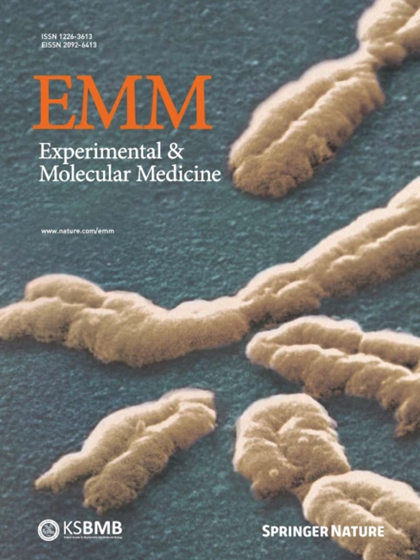Targeting the splicing factor SNRPB inhibits endometrial cancer progression by retaining the POLD1 intron
IF 9.5
2区 医学
Q1 BIOCHEMISTRY & MOLECULAR BIOLOGY
引用次数: 0
Abstract
Dysregulated alternative splicing has been closely linked to the initiation and progression of tumors. Nevertheless, the precise molecular mechanisms through which splicing factors regulate endometrial cancer progression are still not fully understood. This study demonstrated elevated expression of the splicing factor SNRPB in endometrial cancer samples. Furthermore, our findings indicate that high SNRPB expression is correlated with poor prognosis in patients with endometrial cancer. Functionally, SNRPB inhibition hindered the proliferative and metastatic capacities of endometrial cancer cells. Mechanistically, we revealed that SNRPB knockdown decreased POLD1 expression and that POLD1 intron 22 was retained after SNRPB silencing in endometrial cancer cells, as determined via RNA sequencing data analysis. The retained intron 22 of POLD1 created a premature termination codon, leading to the absence of amino acids 941–1,107 and the loss of the site of interaction with PCNA, which is essential for POLD1 enzyme activity. In addition, POLD1 depletion decreased the increase in the malignancy of endometrial cancer cells overexpressing SNRPB. Furthermore, miR-654-5p was found to bind directly to the 3′ untranslated region of SNRPB, resulting in SNRPB expression inhibition in endometrial cancer. Antisense oligonucleotide-mediated SNRPB inhibition led to a decrease in the growth capacity of a cell-derived xenograft model and a patient with endometrial cancer-derived xenograft model. Overall, SNRPB promotes the efficient splicing of POLD1 by regulating intron retention, ultimately contributing to high POLD1 expression in endometrial cancer. The oncogenic SNRPB–POLD1 axis is an interesting therapeutic target for endometrial cancer, and antisense oligonucleotide-mediated silencing of SNRPB may constitute a promising therapeutic approach for treating patients with endometrial cancer. Endometrial cancer is a common cancer in women, with rising cases linked to obesity. This study focuses on a protein called SNRPB, which is involved in RNA splicing. SNRPB is found in high levels in endometrial cancer and is linked to poor outcomes. Researchers used various methods, including bioinformatics and lab experiments, to study SNRPB’s role. They found that reducing SNRPB levels slowed cancer cell growth and spread. They also discovered that SNRPB affects another protein, POLD1, which is important for DNA replication and repair. Lowering SNRPB led to changes in POLD1 that hindered cancer progression. This study suggests that targeting SNRPB with antisense oligonucleotides, which are short DNA or RNA molecules designed to block specific genes, could be a promising treatment strategy. This approach could lead to new therapies for endometrial cancer in the future. This summary was initially drafted using artificial intelligence, then revised and fact-checked by the author.

靶向剪接因子SNRPB通过保留POLD1内含子抑制子宫内膜癌进展。
失调的选择性剪接与肿瘤的发生和发展密切相关。然而,剪接因子调控子宫内膜癌进展的确切分子机制仍不完全清楚。本研究证实剪接因子SNRPB在子宫内膜癌样本中的表达升高。此外,我们的研究结果表明,高SNRPB表达与子宫内膜癌患者的不良预后相关。功能上,SNRPB抑制抑制了子宫内膜癌细胞的增殖和转移能力。在机制上,我们通过RNA测序数据分析发现,SNRPB敲除降低了子宫内膜癌细胞中POLD1的表达,并且在SNRPB沉默后POLD1内含子22被保留。POLD1保留的内含子22产生了一个过早终止密码子,导致氨基酸941- 1107缺失,并失去了与PCNA相互作用的位点,而这是POLD1酶活性所必需的。此外,POLD1缺失降低了过表达SNRPB的子宫内膜癌细胞恶性程度的增加。此外,miR-654-5p被发现直接结合SNRPB的3'非翻译区,导致SNRPB在子宫内膜癌中的表达抑制。反义寡核苷酸介导的SNRPB抑制导致细胞来源的异种移植模型和子宫内膜癌来源的异种移植模型患者的生长能力下降。总之,SNRPB通过调节内含子保留促进POLD1的高效剪接,最终导致了子宫内膜癌中POLD1的高表达。致癌SNRPB- pold1轴是子宫内膜癌的一个有趣的治疗靶点,反义寡核苷酸介导的SNRPB沉默可能是治疗子宫内膜癌患者的一种有希望的治疗方法。
本文章由计算机程序翻译,如有差异,请以英文原文为准。
求助全文
约1分钟内获得全文
求助全文
来源期刊

Experimental and Molecular Medicine
医学-生化与分子生物学
CiteScore
19.50
自引率
0.80%
发文量
166
审稿时长
3 months
期刊介绍:
Experimental & Molecular Medicine (EMM) stands as Korea's pioneering biochemistry journal, established in 1964 and rejuvenated in 1996 as an Open Access, fully peer-reviewed international journal. Dedicated to advancing translational research and showcasing recent breakthroughs in the biomedical realm, EMM invites submissions encompassing genetic, molecular, and cellular studies of human physiology and diseases. Emphasizing the correlation between experimental and translational research and enhanced clinical benefits, the journal actively encourages contributions employing specific molecular tools. Welcoming studies that bridge basic discoveries with clinical relevance, alongside articles demonstrating clear in vivo significance and novelty, Experimental & Molecular Medicine proudly serves as an open-access, online-only repository of cutting-edge medical research.
 求助内容:
求助内容: 应助结果提醒方式:
应助结果提醒方式:


